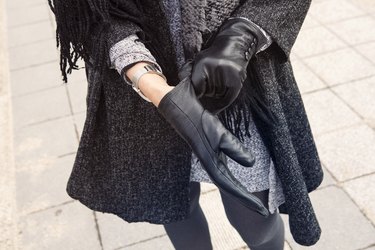
A white spot or white stain on leather gloves can appear for different reasons besides an obvious cause, like spilled milk. These white spots can originate from fats within the leather, but they can also come from mold and salt. Other kinds of damage can also cause leather to lose its unique appearance, and the way you treat it depends on the source of the problem.
White Stains on Leather
Video of the Day
Experts explain that there is a phenomenon called "fatty spue," which is when residual fat in the leather reacts to humidity and temperature fluctuations. It looks like a light white coating and can appear on leather gloves, bags and clothing. Excess humidity and waxy leather care products can cause the white patina to appear. It can be mistaken for mold; use a blow dryer on the white area to tell the difference. If it is fatty spue, it will temporarily (not permanently) disappear, while mold will not budge at all.
Video of the Day
To permanently remove the fatty spue, you'll need a leather stain remover specifically designed for this purpose. There are many products available that can get rid of this problem. To use one, first dust off the white covering with a lint-free towel. After that, all you need to do is apply the leather spue remover product according to the package instructions.
Removing Mold From Leather
Those white marks on your leather jacket could be mold if they don't pass that blow dryer test, and there are ways to remove it. First, make sure the leather is entirely dry and wear a mask to prevent mold particles from getting into your system. Use a damp, soft cloth to wipe off the mold carefully. Once it has dried again, use a mild soap or leather cleaner to clean the whole thing. Allow it to air-dry indoors, as the sun or excessive heat could cause the leather to dry out and crack.
A second technique is to mix a bit of mild dish soap detergent into lukewarm water and gently brush it onto the mold with a soft toothbrush. Add a tiny bit of vinegar to the area and then wipe off everything with a clean, damp cloth. Allow the leather to dry completely and check for any remaining mold.
Other Kinds of Leather Stains
Salt used to make roads and sidewalks less slippery can also get on leather gloves and leave white stains. Some experts recommend dipping a clean, lint-free cloth into a 50/50 mixture of white vinegar and water and applying that cloth to the white spots. You might have to do this a few times until the stains are gone. Once the leather is clean and dry, treat it to some leather conditioner and buff it out. Never polish or condition leather before making sure that it is clean; otherwise, the stains and spots can ground into the leather and be impossible to remove.
Regular Care for Leather
Regular care will keep your leather looking in pristine shape. White marks on leather jackets or gloves can be avoided with proper storage. Store your leather gloves in cotton bags within cool closets or drawers to prevent fatty spue, mold and stains. Exposing gloves to high heat or humidity can cause damage. Keep a good leather stain remover handy because quickly attending to stains and spots increases your chances of getting them out.